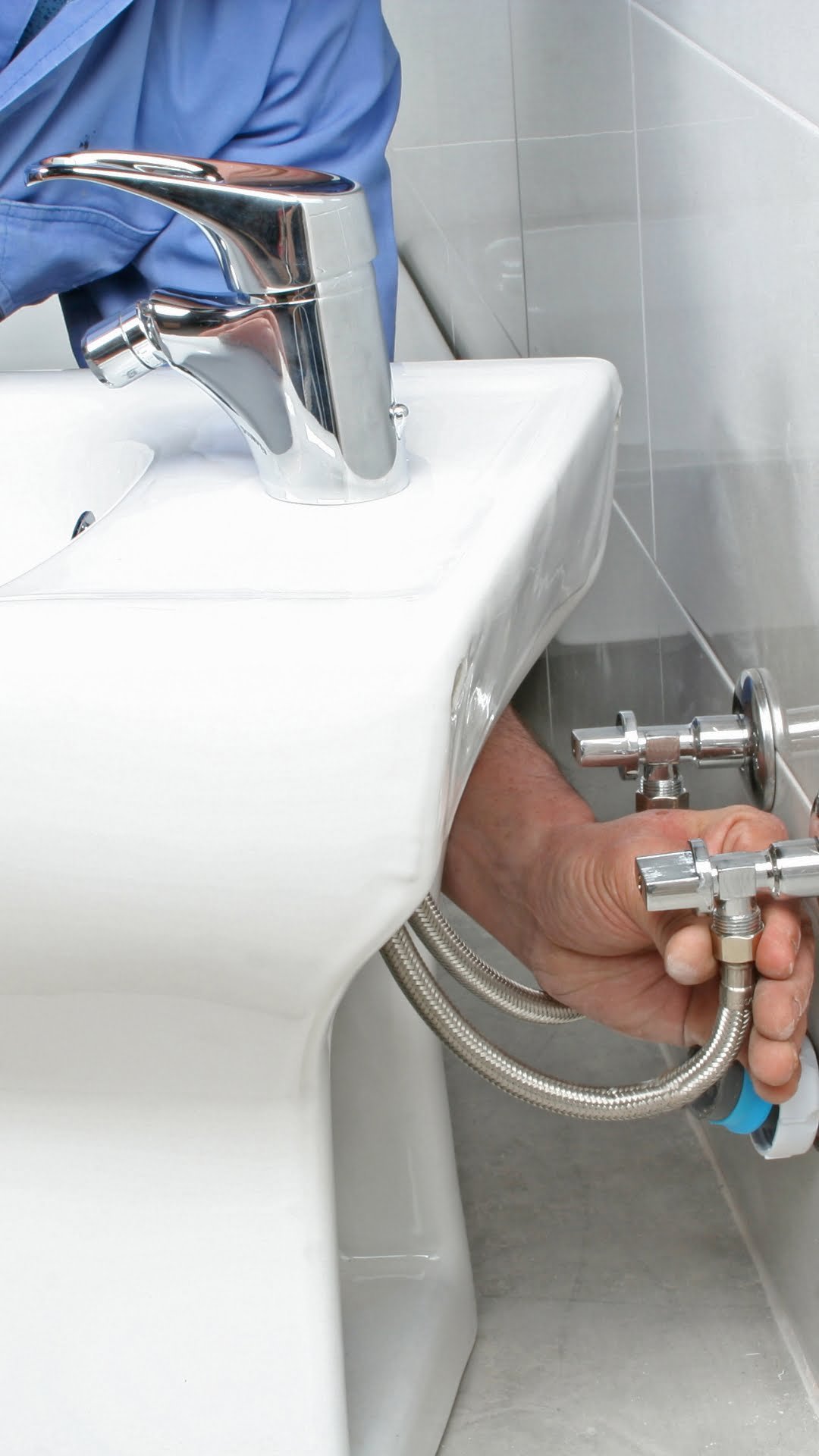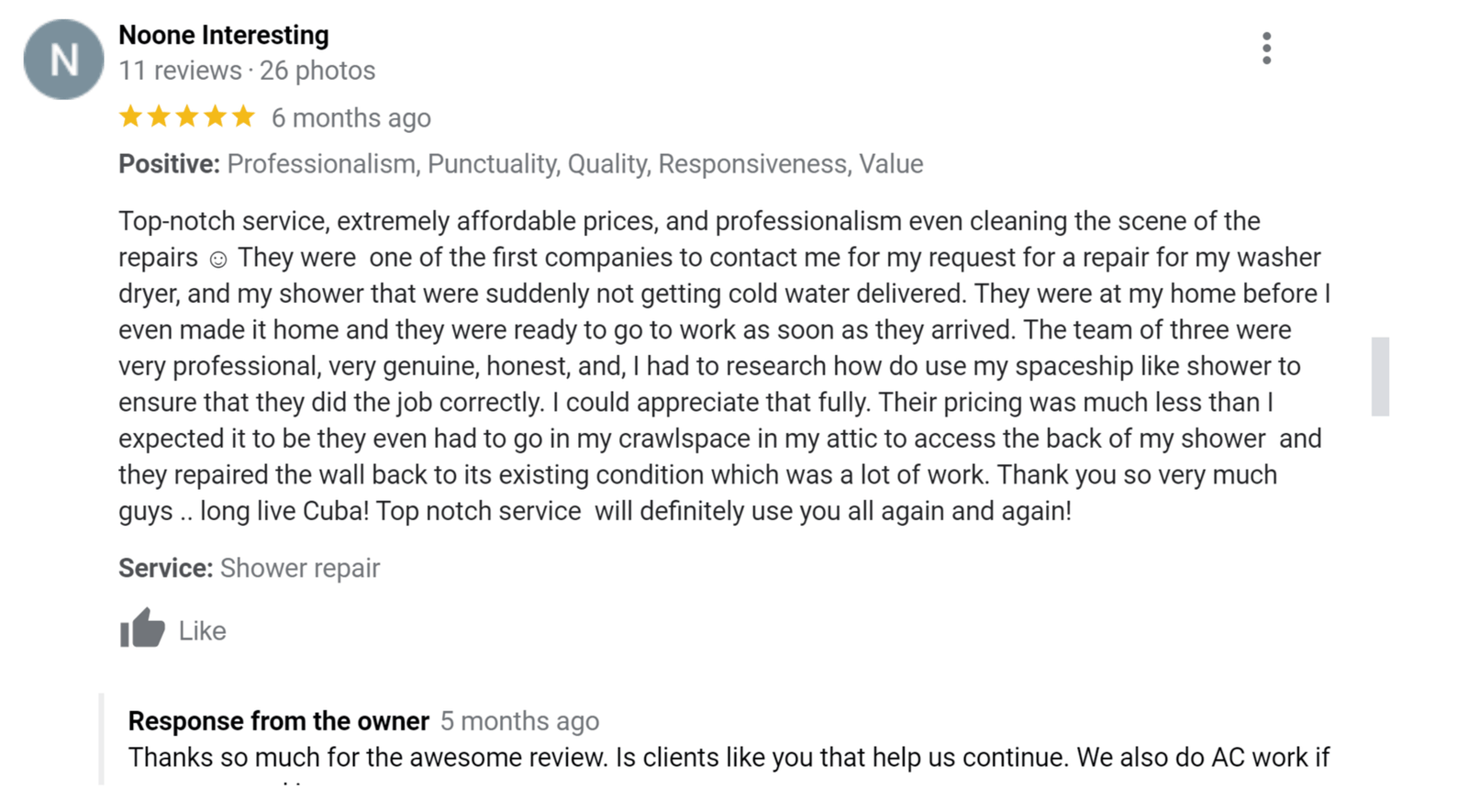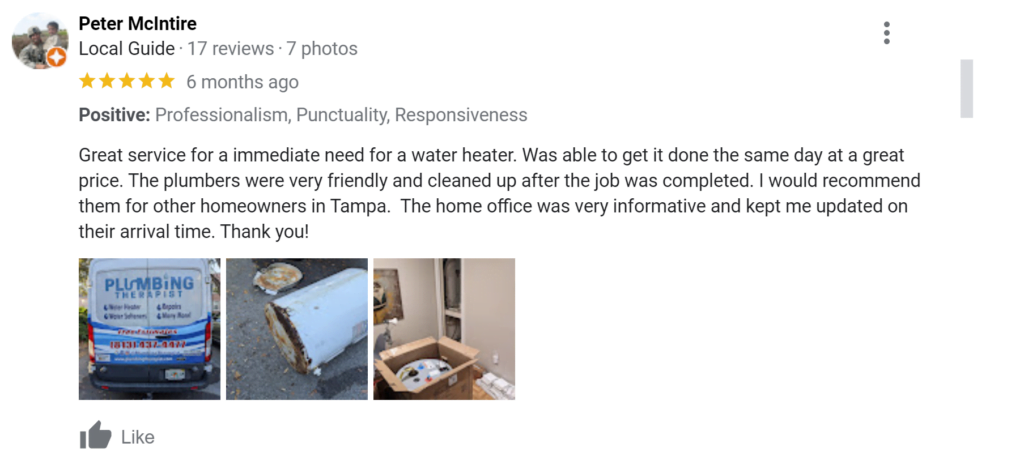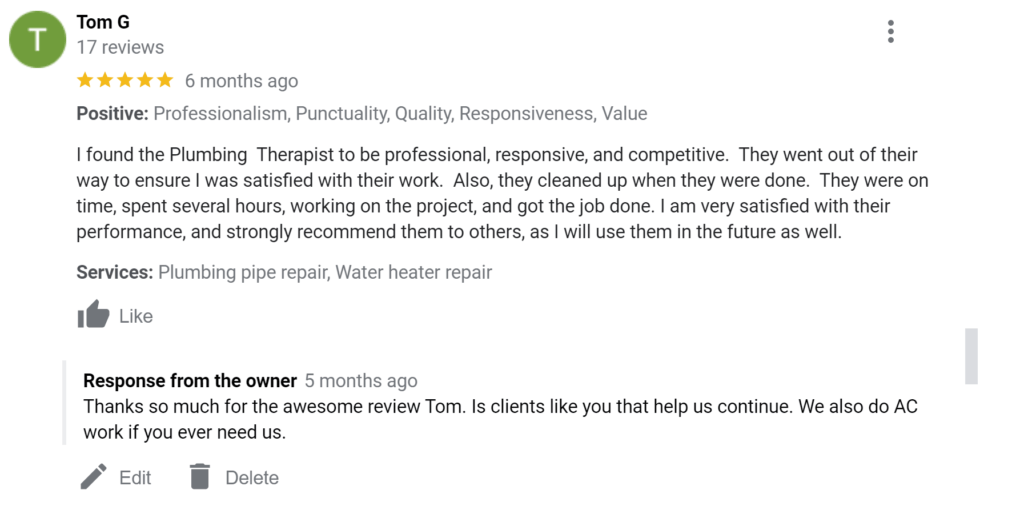Faucet Installation
Professional faucet installation by Plumbing Therapist: Enhance your Tampa Bay home with reliable, stylish fixtures. Quick, efficient service guaranteed.
Do You Need Our Help ?
Feel free to contact us now
$99 Water Heater Flush + Free Plumbing System Inspection
Faucet Installation in Tampa Bay
Reliable & Effective Faucet Installation Services in Hillsborough County, Pinellas County, and Pasco County
Professional Faucet Installation in Tampa Bay
At Plumbing Therapist, we understand that a faucet is more than just a part of your plumbing system – it’s an essential piece of your home’s comfort and style. Our skilled technicians are experts in installing a wide range of faucet types and brands, ensuring a perfect fit for your home’s aesthetic and your family’s needs.
Our Faucet Installation Services Include:
- Consultation and Selection: Work with our experts to choose the best faucets for your home from a wide range of high-quality options.
- Full Installation: From removing the old faucet to installing the new one, we handle everything with precision and care.
- Leak Checks and Testing: We ensure your new faucet operates flawlessly with no leaks or drips.
- Guidance on Care: Our team will provide you with tips to maintain your faucet, extending its life and performance.
Why Choose Plumbing Therapist for Your Faucet Installation?
- Expert Technicians: Our licensed plumbers have the expertise to install any faucet, ensuring a seamless fit and finish.
- Quality Workmanship: We take pride in our attention to detail and commitment to excellence.
- Customer Satisfaction: Your happiness is our priority. We’re not done until you’re delighted with our work.
- Local Service: As a Tampa Bay local business, we’re dedicated to serving our community with integrity and reliability.
Schedule Your Faucet Installation Today
Ready for a hassle-free faucet installation? Contact Plumbing Therapist now to schedule an appointment. Our friendly team is ready to enhance the beauty and functionality of your Tampa Bay home’s plumbing.

Why partner with Plumbing Therapist?
Quality, Affordability, and Expertise.

No Hidden or Unexpected Charges

Free Estimates & Online Booking Available

Professionally Trained Technicians

Honesty is Guaranteed

Quick Communication & Service Within 24 Hours

400+ 5 Star Reviews

Signs That You Should Replace Your Faucet
When it comes to maintaining the faucets in your home, it’s important to recognize the signs that indicate a need for replacement. Here are some key indicators that it might be time to call Plumbing Therapist for a faucet upgrade:
Persistent Dripping or Leaking
A faucet that continues to drip after being turned off can signify worn-out internal components, such as washers or O-rings, which may not always be worth replacing compared to the faucet itself.
Corrosion or Mineral Build-Up
Visible signs of corrosion or a white, crusty buildup around the faucet are indicators of mineral deposits. This can lead to leaks and affect water quality.
Difficulty in Operation
If turning the faucet handle has become a struggle or if it no longer sits in the “off” position without dripping, the internal mechanisms may be failing.
Outdated Design
Faucets that seem outdated or don’t match your home’s style can be replaced to refresh the look of your kitchen or bathroom.
Reduced Water Pressure
A sudden or gradual decrease in water pressure could mean a clog or malfunction within the faucet, or it could be a symptom of a larger issue within your home’s plumbing.
Water Damage
Signs of water damage, such as rust or water stains around the base of the faucet or on the sink, can indicate a slow leak that has gone unnoticed.
Sounds
Strange noises coming from the faucet, like screeching or clicking, can be due to a variety of issues, including problems with the aerator or valve.
Frequent Repairs
If you find yourself frequently fixing the faucet, it may be more cost-effective to replace it rather than continue paying for repairs.
Recognizing these signs early can save you from more costly damage in the future. If you’re experiencing any of these issues with your faucet, contact Plumbing Therapist to discuss your options for faucet replacement and installation. Our team is ready to provide you with efficient, high-quality service to ensure your plumbing is in top condition.
If you would like more information, feel free to give them a call at (813)-437-4477 or you can book online and get their latest discount!
Customer Testimonials: Real Experiences with Plumbing Therapist
We proudly share the experiences and stories of our valued clients. Their feedback provides a glimpse into the quality of service and commitment to excellence we uphold at Plumbing Therapist. You'll read firsthand how our plumbing solutions have improved comfort and efficiency in homes across Tampa Bay. These testimonials illustrate our dedication to customer satisfaction and the difference our expert services can make.




Your questions answered
Common Faucet Installation Questions:
How do I know if I need a new faucet?
Knowing when to replace a faucet is important for maintaining the functionality and aesthetics of your home’s plumbing. Here are several signs that suggest it might be time to consider a new faucet:
Leaks: Persistent dripping or leaking from the faucet that continues after repairs or replacing parts can indicate that a new faucet is needed.
Damaged Parts: If there are visible signs of damage, such as cracks or breaks in the faucet body or handle, it’s time for a replacement.
Rust and Corrosion: Corrosion or rust on the faucet can lead to leaks and water contamination. Once a faucet starts to corrode, it is usually beyond repair.
Poor Water Pressure: If you’ve noticed a significant decrease in water pressure from the faucet and cleaning the aerator or checking for supply line issues doesn’t fix it, the faucet itself might be the problem.
Worn Out Components: Over time, the internal components of a faucet can wear out. If you find yourself making frequent repairs, it might be more economical to replace the faucet.
Mold or Mildew: The presence of mold or mildew around the base of the faucet could indicate a slow leak, which can damage your countertop or sink area.
Inefficiency: Older faucets may not be as water-efficient as newer models. Upgrading to a newer faucet can reduce water usage and save money on your water bill.
Aesthetic and Functional Upgrades: If your faucet is outdated or doesn’t match your home’s style, or if you’re looking for features like touchless operation or improved sprayers, it’s a good time to upgrade.
Noise: If your faucet creates thumping or screeching noises, this could be due to a washer issue or a problem with the faucet’s internal parts.
Difficulty in Operation: Faucets that are hard to turn on or off, or don’t maintain a consistent flow or temperature, may need to be replaced.
If you’re experiencing any of these issues, it might be time to consider a new faucet. Plumbing Therapist can help you choose and install a faucet that fits your needs, style, and budget.
Can I install a new faucet myself?
Yes, you can install a new faucet yourself if you have the necessary tools, basic DIY skills, and a bit of patience. Here’s a simplified overview of the process:
Gather Tools and Materials: You’ll typically need an adjustable wrench, plumber’s tape, a basin wrench, a bucket, and possibly some silicone sealant.
Turn Off Water Supply: Before starting, turn off the water supply valves under the sink. Open the faucet to relieve any remaining pressure and drain residual water.
Remove Old Faucet: Disconnect the water supply lines from the faucet using the wrench. Use the basin wrench to remove the nuts holding the faucet in place. Then, lift out the old faucet.
Clean the Area: Clean the sink surface around the faucet area to ensure a good seal before installing the new faucet.
Install New Faucet:
- Position the New Faucet: Place the new faucet into the mounting holes in the sink.
- Secure the Faucet: From under the sink, secure the faucet with the provided nuts. If your faucet includes a gasket, place it between the sink and the faucet. Otherwise, apply plumber’s tape or silicone to create a seal.
- Connect Water Supply Lines: Wrap plumber’s tape around the threads of the water supply valves and connect the supply lines from the faucet. Tighten the connections with the wrench but be careful not to overtighten.
Check for Leaks: Turn the water supply back on and check all connections for leaks. Tighten any connections if necessary, but again, be careful not to overtighten.
Test the Faucet: Turn on the faucet and let the water run for a few minutes to clear any debris in the lines. Check the hot and cold functions, and ensure the faucet operates correctly.
If you encounter any complications or if you’re not comfortable at any point in the process, it might be wise to call a professional. Plumbing Therapist can ensure that your new faucet is installed correctly and without leaks, saving you time and potential headaches.
How much does it cost to have a faucet installed?
The cost of having a faucet installed can vary widely depending on several factors, including the region, the type of faucet, and whether any additional plumbing work is needed. Here’s a breakdown of potential costs:
Labor Costs: The plumber’s rate can vary based on location and the complexity of the job. In general, labor for a faucet installation can range from $150 to $300.
Faucet Costs: The price of the faucet itself can range from as low as $20 for a basic model to $600 or more for high-end or specialty faucets.
Supply Lines and Fittings: If new supply lines or other fittings are needed, this can add $10 to $50 to the overall cost.
Additional Plumbing Work: If there are issues with the existing plumbing that need to be addressed, such as replacing shut-off valves or repairing pipes, this will increase the cost.
Disposal of Old Faucet: Some plumbers may charge a small fee to dispose of the old faucet.
Service Fees: Some plumbing companies charge a service fee for coming to your home, which can be around $50 to $100.
Urgency and Timing: If you need the installation done on an emergency basis or after hours, the cost may be higher.
For a precise quote, it’s best to contact local plumbing services like Plumbing Therapist. They can provide a more accurate estimate based on the specific details of the faucet you want to be installed and any additional plumbing services you might need.
Will my water need to be turned off for the installation? If so, for how long?
Yes, the water supply will need to be turned off to install a new faucet. This is a standard part of the process to prevent water from flowing while the old faucet is removed and the new one is installed.
The water will typically be turned off at the shut-off valves located under the sink. If these valves are not present or not functioning, the main water supply to the house may need to be shut off temporarily.
The duration that the water needs to be off can vary depending on the complexity of the installation. For a straightforward replacement with easy access and no complications, the water may only need to be off for an hour or two. If there are issues such as corroded valves or the need for additional adjustments or repairs, it could take longer.
Professional services like Plumbing Therapist will aim to minimize the downtime of your water supply and will be able to give you a more accurate time estimate once they assess the specific conditions of your installation. They’ll also ensure that the installation is done efficiently and that the water is turned back on as soon as the job is completed and tested for leaks.
Are there different types of faucets for different uses?
Yes, there are different types of faucets designed for specific uses, and they vary based on functionality, design, and the area where they will be installed. Here are some common types:
Kitchen Faucets:
- Pull-down and Pull-out Faucets: These have a spray head that pulls down or out, offering flexibility for a variety of kitchen tasks.
- Single-Handle Faucets: These mix hot and cold water using one lever or knob.
- Double-Handle Faucets: These have separate handles for hot and cold water and offer more precise temperature control.
- Commercial/Fusion Style Faucets: These resemble what you might find in a professional kitchen with a high-arc spout and a powerful spray.
- Pot Filler Faucets: Installed over the stove, they make it easy to fill large pots with water.
Bathroom Faucets:
- Centerset Faucets: These are made for basins with three holes and have handles that are 4 inches apart.
- Widespread Faucets: These have separate hot and cold water handles that are not connected to the spout, suitable for larger sinks.
- Single-Hole Faucets: These combine the spout and mixing handle into one unit that requires one hole.
- Wall-Mounted Faucets: These are mounted on the wall rather than on the sink or countertop and can create a clean, modern look.
Specialty Faucets:
- Bar Faucets: Smaller than standard kitchen faucets, these are designed for home bars or secondary sinks.
- Utility Faucets: These are often found in laundry rooms or workshops and may have threaded spouts for attaching hoses.
- Touchless/Motion-Detector Faucets: These allow for hands-free operation, which is beneficial for hygiene and convenience.
Outdoor Faucets:
- Hose Bibbs: These are the standard outdoor faucets to which you can attach a garden hose.
- Frost-Free Faucets: These are designed to prevent freezing in cold climates by shutting off water inside the home, preventing water from remaining in the pipe where it could freeze.
When choosing a faucet, it’s important to consider the faucet’s use, the sink or area’s configuration, and personal preference in terms of style and features. Plumbing Therapist can help you select the right type of faucet for your needs and ensure it is installed correctly.
Will a new faucet installation affect my water usage?
Yes, a new faucet installation can affect your water usage, and it often does so in a positive way. Here’s how:
Water-Efficient Models: Many modern faucets are designed to be more water-efficient than older models. They often come with aerators and special flow restrictors that reduce water flow without compromising performance, leading to lower water consumption.
Leak Prevention: New faucets are less likely to leak than older ones that may have worn out over time. A dripping faucet can waste a surprising amount of water over time, so a new installation can eliminate this waste.
Improved Technology: Some faucets offer advanced features like touchless operation or timed automatic shut-off, which can help prevent excess water usage by running only when needed.
Behavioral Changes: The installation of a new faucet might also change your usage patterns. For example, a new kitchen faucet with a convenient pull-down sprayer might encourage you to rinse dishes more efficiently.
Regulatory Compliance: New faucets are typically designed to comply with current regulations regarding water flow rates. For instance, the U.S. Environmental Protection Agency’s WaterSense program certifies fixtures that meet specific water efficiency and performance criteria.
Repair vs. Replace: Sometimes, fixing a leaky faucet is as simple as replacing a washer or cartridge. However, if the faucet is old or the repair is not straightforward, installing a new water-efficient faucet might be the more economical and environmentally friendly choice in the long run.
If reducing water usage is a priority for you, Plumbing Therapist can recommend and install faucets that will help you achieve this goal, potentially lowering your water bills and conserving water.
What is the faucet installation process?
The faucet installation process is a straightforward yet meticulous task that requires attention to detail to ensure everything is done correctly. Here’s a step-by-step guide on how to perform a faucet installation, with an emphasis on the keyword “faucet installation”:
Preparation for Faucet Installation:
- Begin your faucet installation by shutting off the water supply to the existing faucet.
- Clear out the area under the sink to create space for an easier faucet installation process.
Removal of the Old Faucet:
- The next step in the faucet installation is to remove the old faucet. This involves disconnecting the water supply lines and removing the mounting nuts that secure the faucet in place.
Cleaning the Sink Area:
- Once the old faucet has been removed, clean the sink surface thoroughly to prepare for the new faucet installation. This ensures a clean working area and helps prevent leaks at the base of the new faucet.
Positioning the New Faucet:
- Carefully position the new faucet into the mounting holes on the sink. The faucet installation manual should be followed closely to ensure all parts are aligned correctly.
Securing the Faucet:
- Under the sink, secure the new faucet with the mounting hardware provided. This step is crucial in the faucet installation process to prevent movement and potential leaks.
Connecting the Water Supply Lines:
- For the faucet installation to be successful, connect the water supply lines to the faucet, ensuring that the connections are tight and secure to avoid any leaks.
Finalizing the Faucet Installation:
- With the water supply lines connected, the final step in the faucet installation is to turn the water supply back on and check for any leaks. Make any necessary adjustments to ensure the faucet installation is flawless.
Testing the Faucet Installation:
- Test the new faucet installation by running both hot and cold water, checking the faucet’s functionality, and ensuring there are no leaks under the sink.
Cleanup After the Faucet Installation:
- Once you’ve confirmed the faucet installation is successful and there are no leaks, clean up any debris or tools from the work area.
Faucet Installation Completion:
- The faucet installation process is now complete, and you can enjoy the benefits of your new faucet.
Remember, while the faucet installation process can be a DIY project, it’s important to have a good understanding of plumbing systems. If you’re not confident in completing the faucet installation yourself, it’s wise to contact a professional plumbing service like Plumbing Therapist to handle the faucet installation for you. They can ensure that the faucet installation is done efficiently and correctly, providing peace of mind and saving you time and potential complications.
